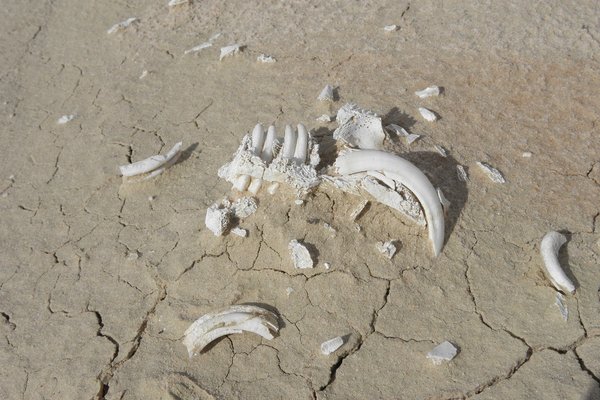Australia
Willandra Lakes
The Willandra Lakes Region is a geologically unique area of dry lakebeds rich in fossils and very early homo sapiens evidence.
They include the world's oldest cremation site (26,000 years old) and remains of a settlement up to 40,000 years ago (agricultural use, stone tools). The lakes dried out about 18,500 years ago. The region is important for research into the Pleistocene in Australasia, when humans became dominant and large wildlife became extinct.
Community Perspective: It’s a wonderful semi-arid desert now, with exposed fossilized trees and bones, and one of Australia's top off-the-beaten-track WHS. Locally, the area is better known as Mungo National Park. Clyde describes getting there and around with a non-4WD car.
Site Info
Official Information
- Full Name
- Willandra Lakes Region (ID: 167)
- Country
- Australia
- Status
-
Inscribed 1981
Site history
History of Willandra Lakes
- 1995: Revision
- Made smaller to enhance its World Heritage values
- 1981: Inscribed
- Inscribed
- Type
- Mixed
- Criteria
- iii
- viii
Links
- UNESCO
- whc.unesco.org
- Official
-
- environment.nsw.gov.au — Mungo Park
- Related
-
- en.wikipedia.org — Lake Mungo hominid remains
All Links
UNESCO.org
- whc.unesco.org — whc.unesco.org/
Official Website
- environment.nsw.gov.au — Mungo Park
Related Resources
- en.wikipedia.org — Lake Mungo hominid remains
News Article
- Feb. 27, 2025 nsw.gov.au — Historic road to Mungo National Park and Willandra Lakes Region transformed
- April 6, 2022 theguardian.com — Mungo Man and Mungo Lady to be reburied in Willandra world heritage area after federal decision
- June 3, 2016 abc.net.au — Mungo Man set to return home by November 2017
- Feb. 26, 2014 theguardian.com — NSW government urged to speed up repatriation of the Mungo Man remains
- July 14, 2010 abc.net.au — A new visitor centre at the Mungo National Park is set to open
Community Information
- Community Category
- Paleontology: Non-hominid fossils
Travel Information
Recent Connections
-
Perfect Inscriptions
1981 -
Sites for which a reduction is or was planned
1995: Reduction of about 30%See whc.une…
-
Fossils
The fossil remains of a series of lakes…
Connections of Willandra Lakes
- Geography
-
-
Notable lakes
Dried lakes
-
- Trivia
-
-
Dubbed as another WHS
Shores of the Willandra Lake system are known as "The Walls of China"
-
- History
-
-
Early Hominid Remains
Mungo Man and LadySee en.wikipedia.org
-
- Ecology
-
-
Fossils
The fossil remains of a series of lakes and sand formations that date from the Pleistocene can be found in this region, together with archaeological evidence of human occupation dating from 45-60,000 years ago. .... Several well-preserved fossils of giant marsupials have also been found here. (OUV) -
Ratites
emu
-
- World Heritage Process
-
-
Perfect Inscriptions
1981 -
WHC locations
Sydney (1981) -
Minor modifications after inscription
1995 (not labelled as Minor Boundary Modification as probably too early for that): "the new boundary will reduce the total area by about thirty percent, adopted the revised boundaries, as they better define the area containing the World Heritage values and will considerably facilitate the management of the property." -
Sites for which a reduction is or was planned
1995: Reduction of about 30%See whc.unesco.org
-
- Human Activity
-
-
Cremation
Site of earliest discovered remains of a human cremation - "Mungo Lady" at Mungo Lake c26-20 000 years ago
-
- Timeline
-
-
Late Pleistocene
The presence of settlements of Homo Sapiens Sapiens is attested to in the Lake Mungo region from ca.-40,000 years.
-
News
- nsw.gov.au 02/27/2025
- Historic road to Mungo National Pa…
- theguardian.com 04/06/2022
- Mungo Man and Mungo Lady to be reb…
- abc.net.au 06/03/2016
- Mungo Man set to return home by No…
Recent Visitors
Visitors of Willandra Lakes
- Alexander Parsons
- Atila Ege
- BenReeve
- Cheryl
- Clyde
- Daniela Hohmann
- Els Slots
- Gary Arndt
- Iain Jackson
- Jarek Pokrzywnicki
- Jarrod_Byham
- Jean Lecaillon
- Jeanne OGrady
- Jens
- Joel on the Road
- Michael Turtle
- Mihai Dascalu
- Nihal Ege
- Petteri
- Philipp Peterer
- Risson
- Roel Sterken
- Roman Bruehwiler
- Sergio Arjona
- Shandos Cleaver
- Tamara Ratz
- Tango
- Thomas Buechler
- tony0001
- Vanessa Buechler
- Zoë Sheng
Community Reviews
Show full reviews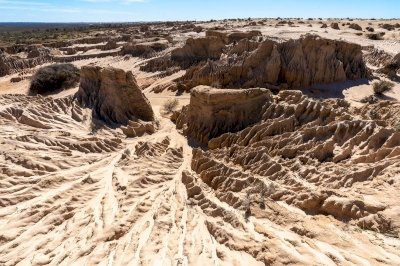
Although the site is officially called Willandra Lakes, it's Mungo National Park (mostly within the boundaries) that is the main attraction and the focus for most visitors. Other parts of the WHS are no more impressive and quite inaccessible, other than views from the roads on the way in. Mungo makes up most of the site, and this is all you'll need to worry about visiting.
For many Australians, Mungo is considered to be 'in the middle of nowhere', but it's actually not too hard to access by car from Melbourne or even Adelaide. From Sydney, it's become a popular stop on a road trip to nearby (by Aussie standards) Broken Hill. Although a 4WD/AWD is recommended, you will be able to get to the site with a normal 2WD if the weather has been good, which means the unsealed roads will be in a good condition. But one of the popular activities - driving the Mungo Track - is best done with a 4WD/AWD.
The geological story of Mungo National Park is fascinating - in short, large lakes dried out about 14,000 years ago and the sand left around the edges has gradually been sculpted into incredible shapes by wind and rain. The most impressive example of this is known as the Walls of China. On your own, you can see them from viewpoints on the boardwalk, but you can walk out onto the sand if you're with an organised tour. I would highly recommend doing this …
Keep reading 0 comments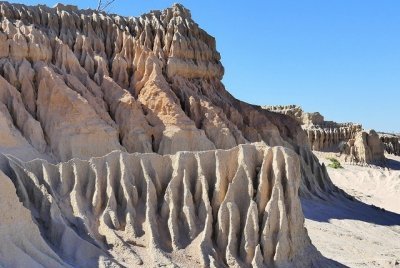
I visited this WHS in January 2018. Since I had read positive reviews on Harry Nanya Tours and reading that a 4WD is more suitable to visit Mungo National Park, I booked way ahead to secure a spot on the afternoon and sunset tour. Communication was swift and I received a booking confirmation shortly after. A few months after I double checked and was told not to worry but to simply confirm my arrival at Mildura the day before or on the day.
Having many other bookings to confirm, I left it at that. While on the road in Australia, our initial plan was to stop at a motel in Bordertown after visiting the Naracoorte Caves NP. However, on the way, luckily we listened to an announcement on national radio stating that most places were going to be on shutdown the next day due to a catastrophic fire alert. Meltwaterfalls' past experience in the US came to mind so I decided to double check my booking with Harry Nanya Tours before driving any further and possibly for nothing.
The call immediately diverted to voicemail countless times and when double checking the contact number on the internet, I learned that Harry Nanya was seriously ill since a couple of months and apparently the tour company does not exist anymore. Already feeling that this was going to be a near miss, I decided to call the Mungo National Park Visitor Centre to see whether or not they would be closed. Surprisingly, a …
Keep reading 0 comments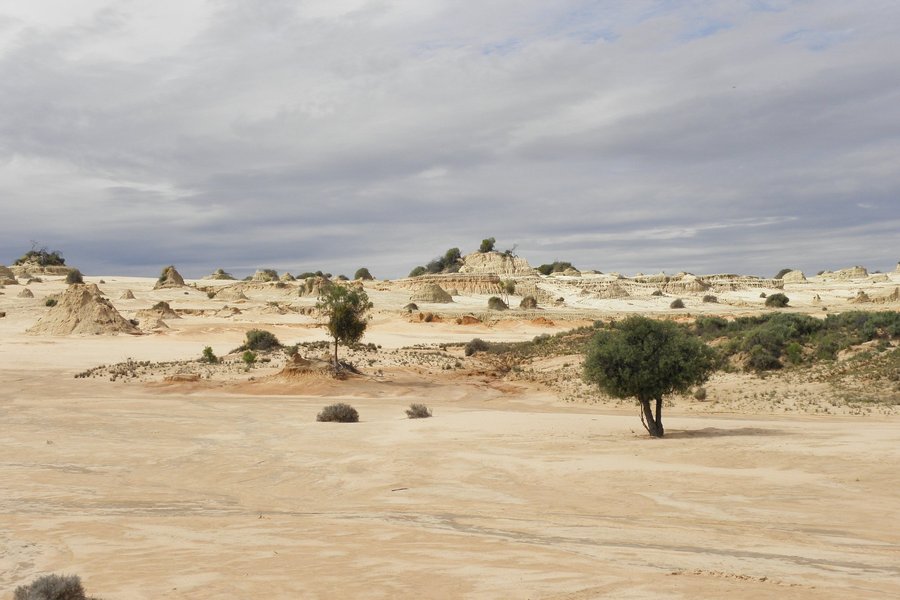
The Mungo National Park is best visited from Mildura that has flight connections to Melbourne and other state capitals.
The road however is unsealed, and we had to rent, on top of our campervan, another vehicle, a WD, just to drive to the parks visitors center.We were there in October during the dry season so the gravel and sand tracks were pretty ok.There is no entrance fee, however, a small amont has to be put in an envelop at the center.Then you place the receipt under the windshield of your car and the adventure can start.
Mungo was a Woolshed in the 18th century, the original buildings are still there.Driving across a dried out lakebed, you soon reach the socalled 'Wall of China' with different layers of geological units in distinctive colours, ranging from pink to grey to brown.There are Rosewood trees, Sugarwood, Bluebush and Eucalypt trees.Mobile Sand dunes that moves with the winds.
We have seen curious Emus and shy Red Kangaroos and some Ringneck parrots.
The track now follows the ridge that divides Lake Mungo from Lake Leaghur.People were living in this area about 60,000 years ago.Traces of Aboriginal occupation was found and is well documented in the small museum of the visitors center.
Keep reading 0 comments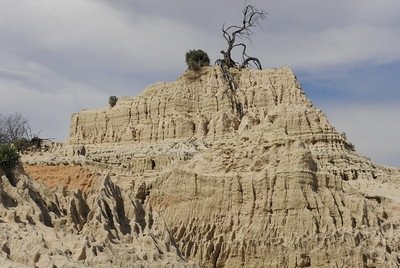
This is a rarely visited WHS among our community (only 5 were there before me), but the park sees a remarkable 80,000 visitors a year. I had always thought that it is pretty remote, but it actually lies within reach for a weekend trip from Adelaide or Melbourne. You can drive out there yourself - it is 90km on an unpaved road, but the surface is not bad (unless it is raining, but then it will be closed). I opted for a day tour to Mungo National Park by minibus from Mildura. Lake Mungo is one of the Willandra Lakes.
After having been out there for a full day, I can only recommend a visit to this precious place. The semi-arid desert with its specific plants, the marvellous colours of the dunes (nicknamed the Walls of China), the fossilized tree trunks and bones that are exposed each day by erosion, the views over the vast former lakes. To put an end to the trampling of the ground, the core area where the fossils are found is now only accessible with an official guide. Our guide, Graham Clarke from Harry Nanya Tours, proved to be excellent. He knows everything about the place, its ecology and the paleontological discourse surrounding the 40,000-year-old Mungo homo sapiens skeletons.
On the way back we were fortunate to see a group of young wild emu up close. They are very curious and came to the side of the road to have a good look …
Keep reading 0 comments
